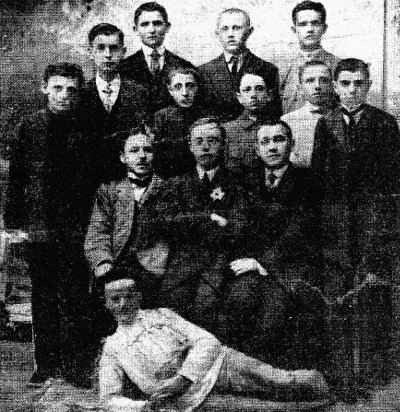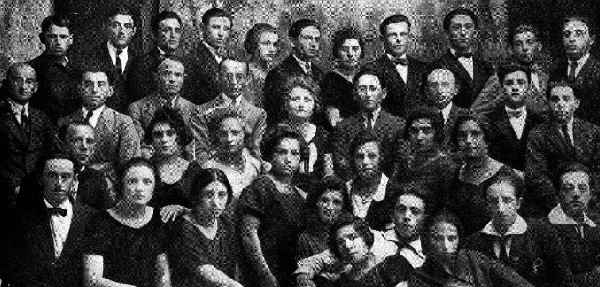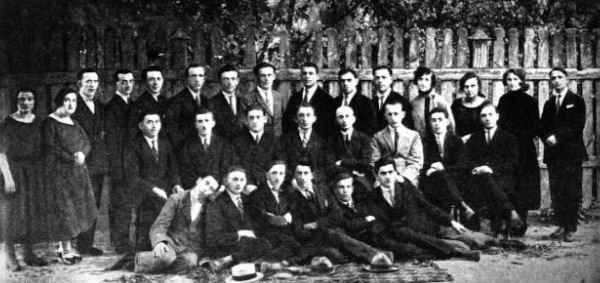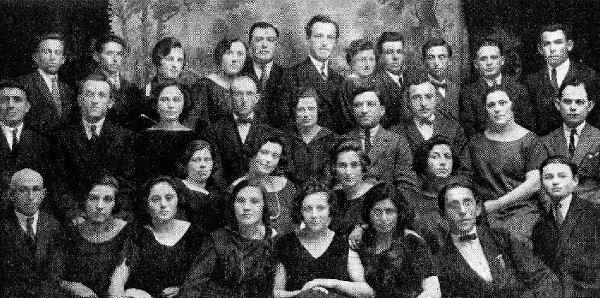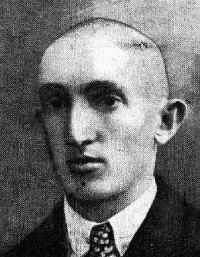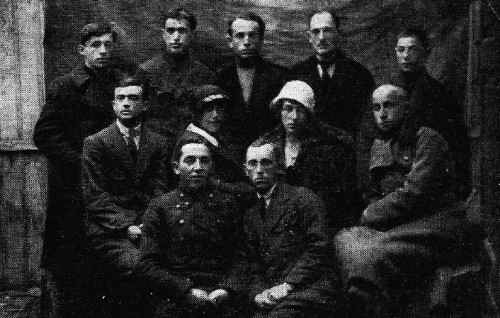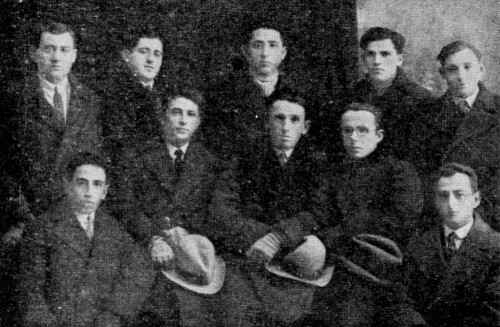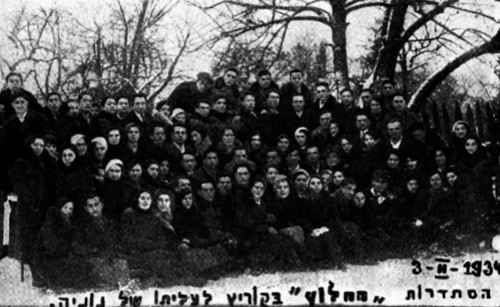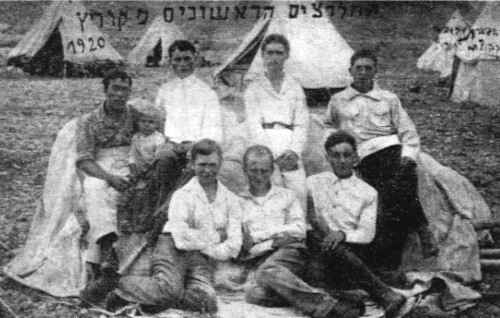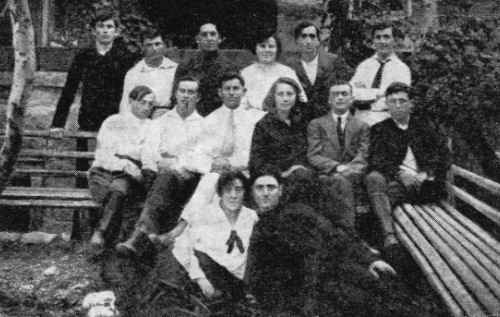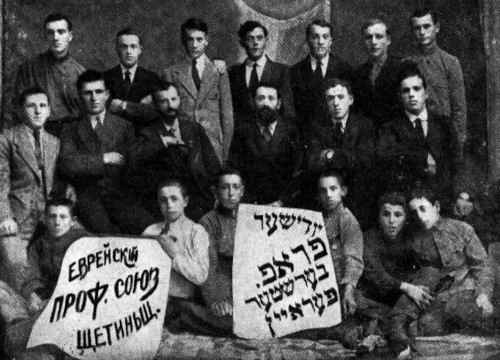[Page 185]
The Zionist Movement
and the Youth Movements
The first buds of Zionism and its heralds in Korets
by Moshe Dafna (Blovstein)
Transliterated by Sara Mages
At the end of the 19th century, and also at the beginning of the 20th century, Korets was still cut off from commercial and industrial centers, tightly closed, and the influence of western culture has not yet penetrated it. This explains why Zionism appeared late in Korets.
A second reason, perhaps the main one, lies in the fact that Korets was a typical Hassidic city. The Makarov's Hassidim and the Trisk's Hassidim were the intellectuals in our city. Almost all the rich people, the merchants and the factory owners, were zealous Hassidim. When the Trisk Rebbe appeared in the city the streets were full of people. The Great Synagogue was too small to accommodate the many Jews who eagerly listen to the Rebbe's words. The Trisk Rebbe's philosophy was based on a verse from Tehillim: “Unless the Lord builds the house, the builders labor in vain.” So, it is forbidden to postpone the end and, therefore, Zionism is apostasy to the Rock of Israel and its Redeemer.
Korets' Hassidim boycotted the Zionist movement and threatened their sons and daughters, with all kinds of threats, not to lend a hand to the “dangerous apostasy” that its name is Zionism. When they learned that their son, or daughter, had joined the Zionist movement, they tore their clothes as a sign of mourning. “Go bring Christ” (the Hassidim's mocking name to Zionism).
The first buds of Zionism in Korets were interesting. Zionist preachers, from the type of the preachers of “Hibat–Tzion,” came to Korets. They preached their sermons before simple people in the synagogues, spiced them with quotations from the Bible and the Talmud, and said them in a special melody and great pathos.
One of them remained engraved in my memory. It was a young man from Šiauliai with long hair and unique appearance. In his sermons he brought, for example, the first Zionist, the prophet Ezekiel, who demanded the revival of the “Dry Bones” from the people. He compared the Jewish nation in the Diaspora to the Valley of Dry Bones and Zionism is the revival dew which will breathe life into them.
The synagogues' Gabbaiim harassed these preachers and turned off the lights during their sermons. There was one preacher, who was firm in his mind and a great believer in Zionism. He shouted at the Gabbaiim; you taught us the Mishnah “He who puts out the candle for the patient to sleep,” meaning, you're interested that the nation should be deep in asleep in the Diaspora and not wake up
[Page 186]
for a revival in Zion. However, we will teach you the Mishnah – “Bameh Madlikin” – we would light torches and show you the right road to Zion. At the beginning of the 20th century, a group of spiritual young people, yeshiva–students who were not satisfied with the Zionism of “Hibat Tzion” and dreamed of a change in values, got together in Korets. At that time I returned from the “Yeshiva” in Novohrad–Volynskyi and continued my studies at “Skvirer Kloize” together with my friend, Berle Schemben, a graduate of “Talmud–Torah” in Korets.
One day we closed the Gemara books, we felt that religious study was not enough and decided to find a way to European education.
This aspiration guided us to “Tarbut” library, which was kind of a “spiritual center” because most of Korets' intellectuals gathered there in those days.
The library was under the supervision of HaRav Mitaam [government appointed rabbi], Nehemiah Hershoren. He made available to us the library hall where the first Zionist circle began to take shape. It was a very disappointing beginning. Only a handful of teenage boys and girls, dreaming and hallucinating, joined it.
The circle did its work underground in fear of the Tsarist regime which persecuted the Zionist movement.
One of the first members of the group, Freidel Boymzeger (Bluwstein), tells the following incident in her memoirs: “We gathered at Kliefeld, “under the mill,” in Garbaska Street. We sat in the dark because we were afraid of being discovered. Suddenly one of our friends came in and told us that someone had informed us and the police was about to surround the house. We fled through the windows and ran toward the river. There were many planks in the frozen river. Our feet sank into them, and with great difficulty we pulled them out. In our run we reached the mountain. From there we went out in pairs to the city and mixed in the crowd.”
However, the circle continued its modest activities despite the persecution of the Czar's emissaries. We gathered for meetings, gave speeches, sang national songs, and began to learn and speak Hebrew.
The same young boys from Batei Hamidrash and the “Kloizim” who had previously walked from house to house and collected candles for Lag Ba'Omer in order to place them on the shelves between the Kloiz's tall windows. A memorial candle, a memorial candle, to have beautiful lighting in honor of R' Shimon Bar Yochai – the same young boys now walked from house to house and to the shops to sell “Colonial Bank” shares and “Keren Kayemet Leisrael” stamps. Those first stamps, white–blue, printed on large sheets and the price of each one was a kopeck.
[Page 187]
I was also one of them. I carried a few pages of stamps, walked from shop to shop and sold them.
Who were the members of the Zionist circle, the founders of political Zionism? It's driving force and chairman was Mr. Yehusua Zalman. He appeared as a preacher and explained the Zionist–political movement at its inception. He was a well–to–do man with a large warehouse of iron goods. In his hands we often saw the foreign Zionist press
|
|
Of the first Zionist in Korets
Standing first row in the back, right to left: 1) Yeshayahu Shapira, 2) Shalom Shifris, 3) Noah Sheindman, 4) Avraham Kleiner
Standing second row right to left: 1) Mendel Feinsman, 2) Moshe–Dov Golod, 3) Sheraga Zavdi, 4) Reuven Berber, 5) Natan Oberstern
Sitting right to left: 1) Yosef Kleiner, 2) Pinchas Avisar (Schwartzmann), 3) Mordechai Zilberman
Lying below: Meir Krosopesach |
[Page 188]
and inside it the “Dzianisz Chronicle.” From that we learnt that Mr. Zalzman was an educated man and knew European languages.
In those days fresh force appeared in the Zionist circle, Yani Hershoren, a medical student in Odessa University and the son of the HaRav Mitaam. He made an impression on the townspeople with his army coat with the shiny buttons. Even though he spoke Russian in the group's meetings, Yani Hershoren brought with him from the spirits of Ehad Ha'am and Bialik. In his school years in Odessa he got closer to the great Hebrew writers who lived at that time in this city. Like his father, Yani Hershoren brought the western culture which was different in its essence from the Hassidic way of life that existed in Korets.
Among the prominent young people were Shmuel Finkelstein and his fiancée, Feiga Zitrin. Finkelstein started his studies as an autodidact, later, he left for Kiev and returned from there a certified dentist.
The Finkelstein's home, which was a Zionist home, excelled in his free spirit. It was an aristocratic home, a nest of noble people. It was one of the few houses in the city that was surrounded by a large garden of fruit trees, well groomed by the father himself.
Among the first members is the unique image of Asher Bluwstein, the director of “Tarbut” library. Bluwstein was possessed with Zionism. He studied it day and night and all his thoughts were subjected to the revival of the nation and the Hebrew language.
He was the first to speak Hebrew in public in Korets. When a person, who knew Hebrew well and not so well, came to the library and spoke Yiddish or Russian with Bluwstein, he didn't answer him unless he spoke in Hebrew.
One of his boldest actions was his penetration into the Yeshiva's walls. Bluwstein smuggled secular Hebrew literature to the Yeshiva. Some of the Yeshiva students kept the book, “Ha–toeh be–darkhe ha–Hayyim” [”A Wanderer on the Path of Life”] by Smolenskin, and even the sexual book, “Haṭṭot Ne'urim” [”The Sins of Youth”] by Lilienblum, in their lectern. All thanks to one of the Lamed Vav [Tzadikim] in our city, Asher Bluwstein, who was one of the pillars of Hebrew culture and Zionism in our city, who dreamed and foresaw that all Diaspora Jews would speak Hebrew at home and outside.
One day, a very interesting figure appeared in the Zionist circle, a man with a deep and profound Jewish education. He had a complete mastery of the Bible, the Babylonian Talmud and the Yerushalmi, and the rich and diverse Talmudic literature. He was Yitzchak Bieber. He came
[Page 189]
to Korets from Novohrad–Volynskyi, Feuerberg's city. Bieber was one of Feuerberg's closest friends and he brought with him the great spirit of, “The Dreamer from Zvhil,” which was one of the most profound Zionist books.
He was the son of a slaughterer and married the granddaughter of Rabbi Mordechai'le, the Korets' judge. He made a living in our city by giving private lessons in Hebrew. At the same time he studied secular studies and was preparing to receive a degree in teaching at the Russian School.
Yitzchak Bieber was a very educated man and an in–depth thinker. He was very popular with the people of the city and everyone respected him and treated him with awe.
A few years later he left for the United States and served as a teacher at the Hebrew Teachers' Seminary in New York.
In the United States he became known as a prominent biblical scholar and also wrote and printed books for the teaching of the Bible that were accompanied by scientific introductions that he authored.
Yitzchak Bieber had a major part in the revival of the Hebrew language in Korets. We had a lot of Beit–Midrash students, who were proficient in the Bible and the Talmud, but for them the Hebrew language was only the language of the book, not a living spoken language, because they lacked the scientific element, the knowledge of Hebrew phonetics and the rules of syntax and knowledge of the laws of the Hebrew language.
Yitzchak Bieber took out the Hebrew language from the “coffin” and breathed life into it. And so was the incident: once, Bieber bumped into me as I was sitting at “Tarbut” library reading “Haṭṭot Ne'urim” by Lilienblum. By chance, I let out a sigh. Bieber asked me: What are you moaning about? for your own “Haṭṭot Ne'urim?” Indeed, yes, I answered. I couldn't find the way to education and for that I'm sorry.
He took me to his home and took care of my knowledge in the Hebrew language for half a year and from that we became good friends.
The first “foursome,” who vowed to speak only in Hebrew with each other, was created in the Zionist group. My friend, Berale Schmben, and I met with two other members of the group, David Salomoniak and Shaul Didibitzer, and without knowing how and what, the four of us started talking to each other only in Hebrew. It was the first intimate group in Korets to use the Hebrew language, as a living language out of national consciousness.
We also became teachers of the Hebrew language and Bible and by doing so we instilled Zionist consciousness in the heart of the Jewish youth in Korets. We gathered around us teenage girls who studied at the Russian School. We talked and preached the Zionist doctoring to them.
I also want to mention those who were among the first members of the
[Page 190]
Zionist circle and worked hard to spread the Zionist idea in Korets. Zitel Schwartzman (mother of the judge Avisar), Aharon Perelmuter, Tehila Finkelstein, Freidel Boymzeger (Bluwstein), Kleifeld, Feige Zukerman (Feldman), and from the young members – the poet Czudner and the judge Pinchas Avisar (Schwartzman) who was the second Zionist immigrant from our city.
Remembered for the best is the beloved woman, Meir–Aba'be, “The noodle maker,” owner of a noodle factory on Brezdiva Street, who made available to us the large hall in her factory for the presentation of the play, “The Matchmaker,” by Shalom Aleichem. The proceeds from the play were dedicated to the development and expansion of the Zionist activity in the city.
I saw that there was no point in continuing my life in the Diaspora, in a city hanging upon nothing, so I made the decision to leave Korets and immigrate to Israel. One year, before I had to go to the army, I received permission and financial opportunity to leave and immigrate to Israel. In my hand I had a document from Mr. David Yelin that I could be accepted as a student at the teachers' seminary of “Hevrat Ezra” which was established at that time in Jerusalem.
I was the only one from Korets, and maybe from the entire area, to immigrate to Israel. I left the city at the end of the summer of 1904.
When I crossed the border near Radziłów, I was forced to give some of my money to the border patrol. I came to Brody in Galicia and in my pocket was not enough money to continue my journey to Eretz–Yisrael. At the immigrants' office a yeshiva student from Brody approached me and invited me to stay in the city for a few months and teach Hebrew in the youth circles in Galicia. Through this work I met Yosef Aharonovitz who came to Galicia a few months before me. He already worked as a Hebrew teacher and Zionist preacher together with Chaim Tretkovar who was a native of Brody and a student in Vienna.
We founded an association for pioneer immigration to Eretz–Yisrael named “Halutzei Zion.” The goal was agricultural work for the purpose of conquering the labor after Yosef Vitkin's call to the youth to immigrate to Eretz–Yisrael. We later found encouragement in the association's aspiration.
After a year and a half stay in Brody I immigrated to Eretz–Yisrael. It was between Purim and Passover of 1906.
[Page 191]
The Zionist fraction “Tze'irei Zion” in Korets
by Meir Panas
Translated by Sara Mages
In our city there was no Zionist General Federation. There were two Zionist parties - “Tze'irei Zion” and “Poalei Zion.” The irony of fate is, at the head of these rival parties stood two brothers, Shmuel Finkelstein chairman of “Tze'irei Zion,” and Motik Finkelstein leader of “Poalei Zion.”
Most of the party's human material came from the ranks of the youth, some of which were rooted in the Russian language and literature.
We had to do the main work, to make a fundamental change in the spiritual foundation of this youth. We assembled them in a clubhouse and began to read before them, in the Russian language, chapters from our national literature and literature of the Labor Zionist Movement.
The days were very turbulent. The Russian Revolution aroused hidden hopes in the heart that the historic injustice to the Jewish people would be corrected. The Jewish youth started to read Zionist writings in secret and in the underground read and delved into the book “Zionism” by Sapir. The center of the national awakening was in Odessa where masses broke out in song and dance in honor of the revolution. Thirteen thousand Jewish students demonstrated in Odessa's streets. They were led by the representatives of “Hahaver” - the federation of Zionist students in Russia.
Leaders of the generation - Bialik, Ravnitzki, Klausner and Ussishkin, sat at that time in Odessa. They called on the youth to prepare for the future because a great hour was about to come.
A seminar for youth counselors was organized. They were instructed to return to their homes in southern Russia and begin Zionist activity among the youth.
As a student of this seminar I returned from Odessa to Korets, after I left it in 1916, and started to organize the youth in Korets.
At that time the youth in our town had to deal with difficult dilemmas. Most was disappointed from the revolution but also couldn't find interest in the official General Zionism.
This youth found great interest in “Tze'irei Zion” party. At that time we received circulars and pamphlets, which spoke in praise of work, from the center in Russia. The article of Yosef Trumpeldor about Degania was also published. The confused youth saw Trumpeldor as kind of a Guide to the Perplexed. His ideas of Hebrew commune and about life of manual labor, matched the desires of the youth in Korets.
[Page 192]
However, “Tze'irei Zion” party would not have taken root in our city without the great assistance of the Finkelstein family. Not only Shmuel, but also his father, the lawyer Hirsh Finkelstein had a great part in implanting of the party's idea in the city. He served as a Gabai in the Great Synagogue and despite the great danger opened the synagogue's gates for the meetings of the Jewish socialist youth.
The Finkelstein's house stood inside a big garden of fruit trees and the leader of the party, Shmuel, turned the garden into a center of attraction for student youth. The party's meetings, conferences and debates, took place in this garden and the daily work was also done there.
I remember that a conversation took place at the entrance to the garden between two students about the forms of settlement in Israel. This argument was of supreme importance for the party. We received booklets in Russian with the the articles of the agronomists Attinger. He spoke in praise of cooperative settlement based on large mechanized economy. On the other hand, we delved into the words of Prof. Oppenheimer who argued for cooperative settlement based on small individual farms. For us, members of “Tze'irei Zion,” it was not an academic argument, but a question of life because the party was a party of fulfillment. We got ready for immigration to Israel and the question, which form of life we would choose as workers in Israel, was very relevant.
The party was active in the field of training the hearts. We received a lot of informational material and the writings of the movement's leaders from the center. We were mainly influenced by the articles of Eliezer Kaplan z”l and Yisrael Marom (Marminsky), may he live long.
We were mostly educated on the left literature and had a regular subscription for the magazine, “Land and Labor,” which was published in Kiev and edited by Marminsky.
The party was very much felt in the city and had many key public and cultural positions. However, as a fulfillment party, it was not always possible for it to hold these positions because all its activists immigrated to Israel.
|
|
Standing right to left: 1) Moshe Berez, 2) Shlomo Sirota, 3) Yontel Schneider, 4) Yakov Glis, 5) Golda Schneider, 6) Berel Goffman, 7) Gisia Fuchs, 8) Zeidel Rochorger, 9) Yakov-Asher Kutler, 10) Yosef Kushter, 11) Mordechai Torknitz
Seated right to left: 1) Berel Vigman, 2) Avraham Gilgon, 3) Moshe Bliman (Hadas), 4) Haim Melamed, 5) Leah Melamed, 6) Dov Bernstein, 7) Tzvi Barenboim, 8) Yosef Wachbroyt, 9) Elik Karas
Third row right to left: 1) Yatom, 2) Guralnik, 3) Chaya Pava, 4) Ester Yaronsky, (Talpiot), 5) Bracha Berez, 6) Feiga Rosendorn, 7) Yosef Berez
Fourth row right to left: 1) Yitzchak Linik, 2) Chaim Poliva, 3) Rivka Bliman, 4) Nachum Wassertrum, 5) Ruth Neiterman, 6) Sosel Burstein, 7) Rivka Oshomirsky, 8) Chaya Kotzer, 9) Tzvi Fabrikant |
[Page 194]
Poalei Tziyon Party in Korets
by Simcha Baraz
Translated by Pamela Russ
The party originated in Korets still in the time of the Tzarist regime, at a time when any Zionist or socialist work ended up with katorga [penal labor in remote colonies] in Siberia. But besides that, there was a group of friends in Korets from the “Poalei Tziyon,” who managed illegal work. They were connected to the Central Committee [highest organ of state power] of the party, and received and delivered illegal literature and also sent out speakers. From time to time, they organized meetings in all kinds of places, or even under the open sky, and when the police found out, everyone ran away as quickly as they could.
When the October Revolution broke out, the party came out into the open, connected themselves to the revolutionary committee, and rented their own locale. Many new people, from many different circles – workers, youth, intellectual students, and ordinary people as well – soon connected themselves to this small group.
In the year 1917, a faction of “Tzeirei Tziyon” already existed. And the following friends were active in the faction at that time: Moshe Bliman, Asher Shicher, Pinchas Yentis, Shmuel Brem, Dov Vigman, Tzvi Barenboim, and Gershon Charbosh.
In the later years, Dov Bernstein joined, and he collaborated until the end to help strengthen the party.
It is worth noting that after the splitting of Poalei Tziyon into right and left, the right wing dominated in Korets and we united with the Tzeirei Tziyon party.
After the unification, the party size doubled in Korets. The first important creation of the party was the founding of the youth organization “Freiheit” [Freedom]. The majority of the Freiheit youth was comprised of workers and school youth. The party created a means of combining political and spiritual life.
[Page 195]
|
|
Poalei Tziyon Party
Standing from right to left: 1) Shalom Zavodnik, 2) Chana Hershenhorn, 3) Chaya Pawa, 4) Hesya Yenes (Kantor), 5) Yisroel Gilman, 6) Mendel Feintman, 7) Reuven Brem, 8) Yakov Gellis, 9) Dovid Gilman, 10) Eliyahu Melamed, 11) Gershon Charbash, 12) Mordechai Sobol, 13) Yosef Baraz, 14) Gnesya Preides, 15) Riva Yosem
Seated from right to left: 1) Chaim Blank, 2) Berel Vigman, 3) Dov Bernstein, 4) Moshe Bliman, 5) Shmuel Bress, 6) Moshe Ber Karas, 7) Asher Shicher, 8) Yosef Vachbroit
Third row, from right to left: 1) Avraham Gilgun, 2) Moshe Gloshower, 3) Shloime Shicher, 4) Chaim Poliwe, 5) Yaakov Pawa, 6) Moshe Vaserman |
[Page 196]
In the professional arena, our party did a lot, taking into consideration the specific circumstances of Korets. The party established a professional union of tailors, which other workers from other areas also joined. The directors of the union were the friends Yontel Schneider, Moshe Gitelman, and Yosef Bekerman.
In the area of culture, our party established multi-branched activity. We did not use the Tarbut library, because we wanted to set up something new rather than maintain the classic revolutionary literature, that was then set up in Poland.
We established our own party library under the name of Ber Borochov, and in a short time there were a lot of books in Yiddish and Polish. The library then became an important place in town. Hundreds of readers from all types of circles used the library and gained so much from the rich treasures.
Within the library, a group for cultural activity was established. From time to time, they organized talks about culture and lectures about all kinds of works. This group was comprised of the following party friends: Asher Shicher, Simcha Baraz, Leibel Zavodnik, as well as the following previously mentioned leftist elements in town: Michel Litvak, Hershel Vivat, Frieda Finkelstein, Yisroel Grinfeld, Mitzik Zafran, and Meir Breindes.
Our literary activities aroused the attention of the extensive circles of the Korets population. The hall was constantly full, and the literary lectures and talks were presented to a great following.
The party also organized “Haoved.” These were skilled workers who did not have the opportunity to go on Hachshara [in preparation for living in Israel]. We conducted important activities with them. The majority of the friends were distant from Zionism for many years, and from many other organizations as well. Through our work, they became dedicated and loyal Zionists.
[Page 197]
The committee of “Haoved” was comprised of the following friends: Shlomo Perelman, Asher Shicher, Dovid Uziranski, Yaakov Reiz, Berel and Eliezer Lipin, Yosef Himelfarb, Yontel Schneider, Avraham Vidro, and Moshe Scheinerman.
That's how the work of the party went until the year 1939, until the outbreak of World War II. The war upended everything. Several friends from “Haoved” managed to save themselves and escape to Israel, but the majority perished, along with the entire settlement.
[Page 198]
The Zionist Labor Party “Hit'achdut”
by David Lidski
Translated by Sara Mages
In 1922, several members undertook the initiative to organize in Korets a branch of the Zionist Labor Party, “Hit'achdut”-“Hapoel Hatzair.” Among the first initiators were: Dr. Hanoch Barles (the first principal of “Tarbut” school), Mordechai Rotberg, Dr. Shmuel Finklstein, Yisrael Melamed, Aharon Sheinker, Yehudah Kiprbend, Meir Gilman, Yitchak Bernstein, and the writer of these columns.
These activists began to carry out informational activities in the spirit of the movement. Many, who believed in the Zionist and pioneering idea, responded to their call and slowly slowly the party began to spread and scored an important position in the public when it appeared as a weighty factor in the Zionist movement in our city.
The party became established and among its members were most of the teachers, pioneering youth, small merchants, officials and independent professionals. In the size of our city it was a “mass” party because it numbered about 150 members.
The members of the party were especially devoted to the activities of “Tarbut” and “HeHalutz.” In addition, they were also active in the work for the national funds, the “League for Working Eretz Yisrael,” and all the Zionist institutions in the city. It organized “Gordonia” youth, was active in the Land of Israel office, “CENTOS[1],” “ORT,” and the community council.
The member, Sheinker, represented the party in Keren Kayemet LeYisrael [JNF]. As a competent speaker he managed, with his cleverness and wit, to overcome his opponent and with stubbornness, dedication and loyalty carried out the idea of movement. Dr. Shmuel Finkelstein was the party's representative in the community and in “CENTOS.” He also served as chairman of “Tarbut” school.
Our party was represented at the party's center by the member, Yisrael Melamed, who perpetuated his name in his dedicated work for the party.
Yisrael Melamed was a typical Zionist activist, from the best Zionist activists that the towns of Wolyn were blessed with. He believed in the doctrine of A.D. Gordon with all his soul. The representatives of the national funds knew that they had to turn to Yisrael Melamed when they came to Korets because he would stand by them in all the days of their visit.
Despite his progressive worldview, Yisrael Melamed was fond of tradition and revered its rabbis.
[Page 199]
|
|
Members of Hit'achdut
Standing right to left: 1) Chaim Musman, 2) Yehusua Steindel, 3) Yakov Rubin, 4) Pinchas Averbukh, 5) Goldberg, 6) Yona Frenkel, 7) Buzia Maliar, 8) Leah Vashkover, 9) Rachel Weinstein, 10) Moshe Litvak, 11) Arye Weinshelboim
Second row, right to left: 1) Aharon Sheinkar, 2) Batia Zukerman, 3) Dr, Barles, 4) Mordechai Rotberg, 5) Leah Rotberg, 6) Yisrael Melamed, 7) Leah Musman, 8) Chaim Roytblit, 9) Yitchak Bernstein
Third row, right to left: 1) Sara Weinshelboim, 2) Sima Nasyuk, 3) Sonia Reizlman, 4) Chaya Averbukh
Fourth row, right to left: 1) Motil Perelman, 2) Yitzchak Skletzky, 3) Mania Litvak, 4) Leah Steindel, 5) Mina Yoresh, 6) Chaya Roytblat, 7) Weinshelboim, 8) Zelig Feiner |
[Page 200]
He married Yehudit, daughter of the city's rabbi, who was a faithful wife to her husband's ambition.
Yisrael didn't know fatigue in his work and visited, on behalf of the center, the nearby cities and towns - Mezhyrichi, Ludwipol, Tuczyn and Hoszcza - to organize the party in these locations and to maintain the contact with them.
Our party, which advocated the slogan “The Religion of Labor” of A. D. Gordon, educated its members to fulfillment. It was among those who introduced the Hebrew language to the young people of the city, engaged in a wide Hebrew-Zionist activity and gave the city a Hebrew character. Indeed, we saw fruit in our labor because many of our townspeople fulfilled their aspiration and immigrated to Israel.
The party was visited by leaders of the “League for Working Eretz Yisrael” - Pinchas Lubianiker (Lavon), Rashis and Funt. However, the 1923 visit of Avraham Levinson, representative of the “Sejm[2]” has become a major event in the cultural and public life of our city.
Even though his visit took place on a weekday, this visit brought us a holiday atmosphere and elation. The Zionist youth organization put aside their regular work and participated in all the parties and meetings that we organized in honor of the guest (the party's club house was located at that time in Hirik's house).
Inside the clubhouse the guest was greeted by a formation of youth from “Hashomer Hatzair “ which was headed by members of the leadership, Czudner, Miziritzsky and Mussman.
With the help of Dr. Zeitlin, Avraham Levinson visited the staroste and tried to obtain a permit from him to arrange public meetings and openly manage the Zionist activity. And indeed, after this visit, our party was declared an official party by the authorities and we were granted permission to do our work undisturbed,
Our party began functioning properly and increased its activity in “HeHalutz,” “Gordonia” and “Tarbut” and its strength was felt in the city.
When it stood at the height of its achievements - the bloody flood fell on the city. The murderer assaulted the Jews of the city. There was no escape and refuge, the members of the party perished together with all the Jews of the city and did not realize their lives' dream.
Translator footnotes:
- CENTOS - Centrala Towarzystwa Opieki nad Sierotami - was a voluntary organization set up in 1924 to unite voluntary child-care organizations throughout Poland under one agency. Return
- Sejm - the lower house of the Polish parliament. Return
[Page 201]
The first members of “HeHalutz”
in Korets
and the torments of their immigration to Israel
by Meir Panas
Translated by Sara Mages
“HeHalutz” in Korets was born on the knees of “Tze'irei Zion” party. It was natural that this party, which drew its inspiration from “The Religion of Labor” of A. D. Gordon, would bring forth pioneers who had fulfilled their aspirations.
The first buds of “HeHalutz” in Korets were already visible in 1918. Its messengers were: Arye Kliefeld, Manos Givoly (Solomianik),Yisrael Solomianik, Yerachmiel Gilman, Meir Panas, and a few others that their names were not kept in my memory.
We began preparing for immigration to Israel. We planted vegetable gardens in our city and for days we prepared ourselves for a life of manual labor. Even though the emphasis was placed on agricultural work, because we all dreamed of kibbutz life in Israel, we were not picky and hired ourselves to homeowners in Korets to do all sorts of jobs. We have to remember that at that time we were all students who had never tasted physical labor and the transition to a life of toil was fraught with agonizing difficulties.
We all understood that this revolution was necessary and received everything with love.
We looked forward to emigration. At the Prague Conference of 1920 a union was formed between “Hapoel Hatzair” and “Tze'irei Zion.” A. D. Gordon and Eliezer Joffe came to the conference from Israel. They called the pioneering Jewish youth to rise and immigrate to Israel. This call reached our city. Then, we decided to fulfill our aspiration and reach the shores of Israel.
“Hit'achdut” established immigration centers in Vienna and Warsaw and the period of the Third Aliyah began. Great enthusiasm took over the youth. There was great excitement. Rumors reached us that the youth in Rowne were preparing themselves for immigration. We read in the press that large youth groups arrived to Warsaw from Poland and White Russia and from there continued on their way to Israel.
On 25 June 1920, the signal was given. On that day the first nine member of “HeHalutz” in our city left for Israel and these are their names: Yerachmiel Ben–Dror (Gilman) – now in Kfar Yehoshua; Yisrael Givoly (Solomianik) – lives in Kfar–Saba; Shmuel Zucker (lives in Tel–Aviv); Pinchas Harpaz (Goldberg) – in Jerusalem; Meir Panas (Kvutzat Kinneret), Haim Zahavi (Goldman)
[Page 202]
passed away a few years ago in Haifa; Shlomo Eisenberg (in the United States); Shmuel Kliefeld (returned to Korets and perished in the Holocaust).
|
|
Second group of immigrants from Korets on its way to Israel, November 1920
Standing right to left: 1) Shaul Givoly (Solomianik), 2) Zindel Kotlir, 3) Moshe Gechman, 4) Eliezer Ben–Yisrael (Ashel), 5) Arye Kliefeld
Seated right to left: 1) Manos Givoly, 2) Klara Givoly, 3) Leah'ke Tzmukler, 4) Arye Ashe
Third row, seated right to left: 1) Moshe Don, 2) Michael Sheinkar |
However, leaving Korets was as difficult as parting the Red Sea. A Polish–military regime ruled the city and it was almost impossible to obtain a travel permit to Rowne or Warsaw. With great effort we obtain identity cards approved by the local government, but they had to be approved by the military authorities. The military commander sent us to the military police department, which was located at the “Warshavsky Hotel,” and there they beat us with murderers' blows.
Relief and salvation came to us from another source: Young smugglers from Rowne, who were in contact with the army, occasionally came to Korets. They were young Zionists who, in the evenings, sought contact with the Zionist club and pioneering youth. We poured before them our bitter words that we were locked in and not allowed to leave.
In one of this conversation one of the young men advised me to come to a certain hotel in Korets where he arranged a meeting with a military policeman who was one of his best friends.
[Page 203]
When I got there, I poured my heart before the policeman to let me escape from the Bolsheviks (the Polish army was in constant retreat) and immigrate to Eretz–Yisrael. My aim was to reach the Eretz–Yisrael Office in Warsaw and from there to continue on my way to my homeland. However, the policeman poured out his rage on me, threw my identity card and exclaimed – “It is not true that Eretz–Yisrael is your heart's desire, you want to flee to Poland.”
However, the young man didn't give up. He tried before the head of police and he agreed to let us leave under these conditions: he had to send two policemen to Rowne. If we get carts, he is willing that the policemen will accompany us and no one would harm us.
I left for the street with Yerachmiel Gilman to look for carters. The streets were deserted because everyone locked himself in his home for fear of the rioters who beat, robbed, and murdered.
With great effort we arrived to Pitzi – the leader of Korets' carters. He pondered and finally agreed because his heart broke inside him when he heard our pleas which were soaked with tears.
At 11.30 before noon, two carts arrived behind our house and next to them stood nine members of “HeHalutz” who were immigrating to Israel. It must be that a bird spread the rumor – the street was flooded with men and women who came to say goodbye to us. What kind of a powerful hidden force brought these Jews because we kept our departure from city as a secret. There were scenes that I would never forget: some cried bitterly, and some whished us that we would arrive safely at our destination.
In this manner we, a small handful of Jewish Halutzim, left Korets on Friday afternoon, 25 June, 1920. What did we take for the road? a small backpack with almost no clothes and a few pennies. The religious parents put a sack of Tefillin in the bag, and there was someone who had equipped his son with “Sefer Raziel HaMalakh” [”Book of Raziel the Angel”] that, as we know, is a guaranteed remedy against fire.
When we arrived to Hoszcza all its Jews were already dressed in Sabbath clothes. When they saw the carts they called out to each other: Already fleeing from Korets! Here, the first refugees arrived.
At night we arrived to Rowne. There, we learned that we had left Korets only a few hours before the Bolsheviks entered the city. Our friends from “Tze'irei Zion” and “HeHalutz” housed us at the Joint's [JDC] shelter for orphans.
We spent a few days in Rowne because it was impossible to continue. The roads were blocked by the retreating Polish army. Miraculously, the porters agreed to let us enter the military train which made its way to Lusk and Kovel.
[Page 204]
On a moonlit night we climbed, together with Rowne's Halutzim, to an open car loaded with railroad tracks that the Poles had dismantled in their retreat.
When we entered we imagined that we were already in Eretz–Yisrael and a lively discussion about it began. What will we ask when we reach Israel? A few said: we will go straight to Hamrah (near Tel–Hai). Others were more cautious and said: we will go first to Tel–Hai, There was also one who spoke in praise of city life, and we looked at him as if he was a deserter. As we were still arguing a fire broke out in our car despite the book “Raziel HaMalakh.” The train stopped and the manager decided that since this car was the last, it was necessary to disconnect it and the train will continue on its way. When we heard this decision it was as if thunder had hit us, but we recovered and jumped, an acrobatic jump, into the front cars.
Toward morning we reached Kovel. We went into town and met a man from “HeHalutz” in Rowne who was returning from Warsaw. He, in particular, dealt with the immigration of members of “HeHalutz.” He told us that the center in Warsaw complained that we left for the road without permission because many want to emigrate and we have to wait for our turn.
Instead of permits for immigration this emissary brought with him a bag full of rubber stamps intended for branches of “HeHalutz” in the Wolyn district. Among them was also a stamp for the brunch of “HeHalutz” in Korets. The rubber stamp was round, inside was a Star of David, and inside it a sheaf, a hammer and a scythe.
The first act of that messenger was to stamp the permits with the seal of “HeHalutz” which caused us trouble as I shall tell below.
A few days after we arrived to Kovel we broke into a train, some through the door and some through the window, in order to arrived to Warsaw. Near Brest–Litovsk a police guard came in and began to check our documents. In one of us they discovered a document stamped with “HeHalutz” stamp. The Poles were afraid of the Bolsheviks and when they saw the stamp they were sure that we were communists.
They did not return our documents despite our many pleas, and when we arrived to Warsaw we saw that we were surrounded by the train's policemen. They ordered everyone to get out, but ordered us not to move from the place. We were led to the police station and placed inside a wooden cage which was filled to capacity with criminals of all kinds. We stood pressed and cramped.
[Page 205]
We were approached by investigators in civilian uniform who threatened us through the bars: Communist Jews! We'll show you!
Toward evening they began to take us out, one at a time, for interrogation. They asked us, who and what are you, and when we answered that our destination was Eretz–Yisrael, they began to scream: You are liars! You are a communist cell that secretly prepares a Bolshevik invasion of Poland.
With us was a Halutz from Rowne, today the folklorist Dr. A. Bavli. He went to the police chief and asked him: what will happen to us at the end? You did not give us food, and you also denied us the opportunity to contact our relatives to let them know where we are.
The commander agreed that two policemen would accompany him to his “uncle.” He invited the policemen for a cup of tea and when he became friendly with them he walked with them to Karlovaska Street, the address of the Eretz–Yisrael Office.
The policemen stood up and asked in amazement: This is where your uncle lives? After all, these are offices. Bavli did not get confused and replied that his cousin was working in this place. In this manner we notified the Eretz–Yisrael Office of our existence and then the Sejm began to take care of our release.
A few days later we have been told that we were being transferred to “Pubozek” – an isolated camp of Russian–Communist POWs. They locked us in a narrow room, shaved our heads, arranged us in groups of two and beat us to death. The weak and the slow were beaten with rifle butts.
We received food from the Eretz–Yisrael Office. One day, at noon, an emissary came and told us that very soon we would be transferred to Gorochov farm.
We spent two weeks in Gorochov and from there the Eretz–Yisrael Office transferred us to Krakow. In this city there were already groups of immigrants from “Hashomer Hatzair.” They obtained visas for us for Czechoslovakia and we arrived in Pressburg [Bratislava]. We were housed in the stable of a Jewish estate owner. They supplied us with British visas and we arrived in Vienna. From there, the group continued and arrived, in August 1920, to the shores of Eretz–Yisrael. I arrived at the end of December of that year because I fell ill and lay in a hospital.
This is the Odyssey of the first members of “HeHalutz” in Korets, to teach our sons, who would follow us, how strong our love for the land of our forefathers was, and how much suffering we endured until we were able to grace its soil.
[Page 206]
“He-Halutz” in Korets
by Y. D.
Translated by Monica Devens
“He-Halutz” in Korets was a flourishing branch of the famous tree of the pioneer movement in Poland. Its first buds were seen in our city already in 1918 with the immigration to Israel of the first of “He-Halutz.” However, “He-Halutz” as a movement was founded in 1921-22.
The founders were: Pinchas Yaniv (Yentis), Asher Shikher, Yisrael Melamed, Moshe Hadas (Bliman), and Shmuel Bar'am. We did not have a hall of our own and we gathered at the “Tarbut” club on Kosciuszko Street, at the house of Shtilerman. We started with few, all in all 25 people.
In 1925, “He-Halutz” broadened the scope of its activity and took on the character of a popular movement. The branch in that year counted more than 100 people. We ceased being dependent on others and rented our own hall in Brezdova Street, at the house of Tessler.
“He-Halutz” introduced a revolution to the calm household experience in our city. For many generations in the diaspora, our ancestors were of the opinion that a Jew and physical labor were two ideas that contradicted each other. They knew well what was written in the Tanakh that drawing water and chopping wood were the work of the “Gibeonites” and not of the daughters and sons of parents with households of learners and rabbis. And so, we were incomprehensible in the eyes of the surroundings in which we existed. They looked at us like at wonders (“chudakes”) or like people in whom spirited and naughty winds had entered. They did not delve into the idea that this small handful of young women and men were the harbinger of great and foundational change in the lives of the Jews, that symbolized the passage from spiritual Judaism, detached, to worldly Judaism, living by the work of its hands.
From what did we imbibe these ideas? There is no doubt that the ideology of “He-Halutz” was based on ancient sources. Our ancients heaped great praise on work and labor. There were in our city, in particular, many knowledgeable people among the young generation who knew the teachings of the Rishonim [=11th to 15th century important rabbis] and the Achronim [=important rabbis from the 16th century onwards]. They were proficient in the “Religion of Work” of A. D. Gordon, delved deeply into the theory of “change of values” of Berdyczewski, which advocated the creation of a new Judaism, territorial Judaism, and many of them delved deeply into the writings of Brenner, a great opposer of the diaspora.
We saw in the event that awakened our city from an economic viewpoint and that there was an urgent need to change the specific Jewish ways of making a living and to go out into the wide space of the life of work and creation.
[Page 207]
We organized a training group - a group of loggers. They used to bring long logs. We took it upon ourselves to split these trees according to the wishes of the owners. Gentiles did this work since ancient times. We tasted the bitter taste of “work conquering.” More than once serious arguments between us and the gentiles broke out since they didn't want to give up their monopoly on this “goyish” work.
The “He-Halutz” center maintained that this wasn't sufficient and we had to go out to one of the training points for real training. The “He-Halutz” branch organized a festive going away party for the first group that went out for training.
The activity of “He-Halutz” did not limit itself only to physical training, but also believed in spiritual training. The first thing we did was organize groups for the study of Hebrew, Jewish history, the history of Zionism, and the Labor Movement in Israel. We were seriously aided in the acquisition of the Hebrew language by the teachers, David Solomianik, Ahiezer Rotblit, and Meir Gilman.
We arranged literary parties around different topics whose income was dedicated to Kapai [=Land of Israel Workers Fund].
|
|
The “He-Halutz” Committee in 1929
Standing from right to left: 1) Moshe Smolier, 2) Yosef Wachbroit, 3) Yom-Tov Schneider, 4) Chaim Zuker, 5) Menachem (Mendel) Gorben
Sitting from right to left: 1) Yosef Kligerman, 2) Yitzhak Wilner, 3) Eliezer Basyuk, 4) Simcha Baraz, 5) Aryeh Zabodnik |
[Page 208]
“He-Halutz” also invested a lot of energy in working for the Keren Kayemet [=Jewish National Fund]. Over many years, it claimed the fourth place in the city.
The branch earned the visit of emissaries from Israel - Berdyczewski, Ben-Ari, Teyger, Funt, Ritov, Shenhavi, Pinchas Lubianker (today secretary of the Histadrut), etc. They lectured about the Labor Movement in Israel and about the functions of “He-Halutz” and the kibbutz. These lectures drew a large crowd, mostly those opposed to Zionism and “He-Halutz.”
Since Korets was a book town, in 1927 we arranged a regional gathering in which representatives from Mezhyrichi, Hoshcha, Ludwipol [=Sosnove], and Rovno [=Rivne] participated. From the center of “He-Halutz,” the members of the Maharshek family, Betty Bendersky, and Zukerman participated. The gathering took place in the “Tarbut” hall and lasted three days.
Kibbutz Klosova [=Klesiv] served us as a lighthouse in our educational work. In addition to the fact that many of our members got their training there, the branch maintained a strong connection with the very center of the training movement in Poland.
The bloody riots that broke out in Israel in 1929 brought about the closure of the gates of immigration by the Mandate government.
One of the most severe crises befell the pioneer movement in Poland following the locking of the gates of Israel. What came were days of a complete lack of interest. The training movement was in mourning. For many years, members of “He-Halutz” looked forward to immigrating to Israel and now they remained stuck, closed in, and sealed shut.
Many looked for other ways to reach what they desired, but those who did not have suitable financial means - remained hopeless and full of despair.
There were those who were unable to wait until the gates opened again and they left the training groups and returned home. Among them were also some of the Korets pioneers. However, the majority held fast and believed completely that even though the opening of the gates tarried - it would surely come.
With the founding of “He-Halutz Ha-Tza'ir” in Korets, “He-Halutz” gave a lot of help to this organization, which was destined to become the reserve forces of “He-Halutz,” and the founder of “He-Halutz Ha-Tza'ir,” Noach Dagoni (Nunya Hecht), was chosen as the secretary of “He-Halutz.”
It was 1931. The gates of Israel opened. Many went for training. “He-Halutz” flourished and our club thrived and was full of vitality and bustled with life. Many dozens of the members of “He-Halutz” went for training and some of them immigrated to Israel. Not everyone had the travel expenses and “He-Halutz” organized an aid project to help those who were most in need.
[Page 209]
|
|
| 3-II-1934 The “He-Halutz” Organization in Korets at the Immigration of Nunya |
[Page 210]
Immigration to Israel flowed then in great measure. They immigrated, not just by means of training, but rather following requests from Israel, as students to the Hebrew University, illegally, with fake documents, and through fictitious marriages.
These means were a source of rescue of dozens of youth who succeeded in this way to be saved from the Holocaust that came upon the Jews of Korets. The youth that remained in the city continued with their work, but sadly, many of them weren't granted the privilege of immigration and perished in the Holocaust.
In 1935 the “He-Halutz” committee was made up of these members: Yitzhak Dagoni (Hecht), Reuven Kipret, Aryeh Zabodnik, Yehezkel Weintuch, Zvi Molier, Chaya Kristol, and Mina Mabler. The branch counted 80 members.
The main work of this year was organizing a Working Israel block and distributing shekels in advance of the 19th Congress. And, in fact, of the 651 shekels that were distributed then in the city - the Working Israel block distributed 486. In this year, “He-Halutz,” in partnership with “Poale-Tzion,” organized a branch of “Ha-Oved” in Korets. The first ones of “Ha-Oved” who received permission to immigrate were Zvi Fabrikant and Rachel Rozendorn.
Following the pogrom in Przytyk in 1936 and the anti-Semitic propaganda in Poland, announcements whose content was anti-Semitic appeared in Korets also. “He-Halutz” brought together, then, the youth organizations and it was decided to organize defense in the form of night watches against the rioters. Luckily, this was a preventive action only and we did not have to use defensive weapons in practice.
The great majority of the members of “He-Halutz” were devoted to the Labor Movement in Israel and occupied important positions in the various branches of labor and creation.
The heart breaks that only a few of them were able to escape the vale of tears and to don the mask of new life that continues to be created in Israel. The great majority did not achieve this and the song of their lives ended in hard suffering that cannot be described.
May these lines be a monument to these dear friends of ours who left us not to return.
[Page 211]
The First Korets Pioneers - in Immigration and in Labor
by Shmuel Zuker
Translated by Monica Devens
1920. The war between Russia and Poland ignited. With the pressure that the Red Army put on Warsaw, the armies of Poland retreated and Korets was about to be conquered by the Soviets.
At the same time that the new regime was about to be established in our city, several pioneers, including myself, left and went to Rovno [=Rivne] to join the group of the first pioneers who intended to immigrate to Israel.
In Rovno [=Rivne] we found the group of pioneers as they hurried to get on their way out of fear that perhaps the Bolsheviks would get ahead of them and hinder them. Confusion and fear prevailed in the city and, as we were about to leave, we were snatched up by the authorities for the work of loading munitions onto the trains.
After many adventures, one night's imprisonment in Kovel and two weeks' imprisonment in Warsaw, as those accused of spying on behalf of the Bolsheviks - we succeeded, with the help of the Israeli office, to head out to Bratislava in Czechoslovakia, where hundreds of pioneers from Poland concentrated. We spent about six weeks in Bratislava and, because the place was too small for the many pioneers,
|
|
Standing from right to left: 1) Michael Schenker, 2) Moshe Zuker, 3) Shmuel Zuker, 4) D. Dvorah'es (holding a child)
Second row, from right to left: 1) V. Gilman, 2) Meir Panas, 3) Shaul Givoli |
[Page 212]
they transferred some of them outside of the city, to a village Jew who put one of his sheds at our disposal. The days of anticipation dragged on there for a long time and day after day, we forced the issue.
Finally, we got the visas and we set out for Vienna and from there to Trieste. We boarded the ship, “Carlsbad,” and after much wandering from place to place over thirty days, we arrived in Israel on Simchat Torah of 1924.
|
|
Standing from right to left: 1) Chaim Fiszer, 2) Simon Finklesteinm 3) Gena Stambulchik, 4) Michael Schenker, 5) Freydes (Simcha's brother), 6)
Sitting, from right to left: 1) Aryeh Kliefeld, 2) Aryeh Eshel, 3) Leah'ke Tsmolker, 4) Schneider, 5) Pinchas Goldberg, 6) Chaim-Yitzhak Vajnshel
Sitting on the ground: 1), 2) Fanya Stambulchik |
On the unpaved Jaffa-Tel Aviv road, we trudged after camels loaded with our baggage to one of the shacks on sand hills that surrounded the place, which today is the site of the municipal “Hadassah” hospital. There we were housed by the immigration division of the Zionist Federation.
After a few days, the worry about work began to gnaw at our hearts. What will we do? Because there was no work where we were. We had hoped for the beginning of communal labor that the Mandate government had promised to bring about.
Three weeks after our immigration to Israel, “Ha-Po'el Ha-Tza'ir” [=a Zionist youth movement] got the paving job for the Afula-Nazareth road and the happy, hoped for moment arrived: we became workers
[Page 213]
in Israel. The work and the conditions were very difficult, but we accepted it all with love and we worked with enthusiasm and high spirits. The idea of vanquishing work, whether in the city or in the village, grated in the air then and excited the mind. And when the information reached us that we had to send a group of people to Haifa to unload coal from one of the ships in order to occupy a position in this back-breaking work, too, that was always done by Arabs - we volunteered and went out to conquer this work, too.
I must note, for truth and precision, that in those days, work like this was done for just some poor food and some clothing only. We didn't see any money and didn't get any. But with all this, we were not angry, we didn't complain to anyone, because the feeling of pioneering that was in our work gave us much satisfaction.
After some time, they brought us to finish the Haifa-Jedda road, the paving of which was given to “Ha-Po'el Ha-Tza'ir.” At the same time, some of our members were called to the laying of the Lod-Sarafand [=Tzrifin] train tracks, which occurred in very difficult conditions, but was a necessity to complete.
When we completed the work on the Haifa-Jedda road, we went to Jerusalem for construction work. There wasn't a lot of work and the conditions weren't easy. We began to work on building the Diskin orphanage. Little by little, the work moved along and expanded and the conditions improved even. From Jerusalem we moved to “Kvutzat Kinneret” and afterwards to the moshav, Tel Adashim.
Little by little, we planted roots in Israel and even began to think about the immigration of our relatives. The pioneers of Korets made a not insignificant contribution to the building of Israel. With their sweat and their work, they helped its desolate places to bloom.
[Page 214]
The Professional Organization and “Ha-Oved” in Korets
by Yontel Schneider
Translated by Monica Devens
At the “Poale-Tzion Socialist Zionists” council held in Warsaw in 1920, the party decided to penetrate the professional movement, which was in the hands of the “Bund” and the Communists. Notices were sent to all the branches of the party in which they were instructed to act accordingly.
There was no professional association in Korets. As a member of “Poale-Tzion,” I received a letter from the center in Warsaw saying that the party in Korets was responsible for establishing professional associations.
An organizing committee was founded made up of Shlomo Gitelman, Meir Gilschlak, and the author of this article. We decided to establish a joint association of tailors and carpenters. We turned to the Starosta and requested suitable permission. The answer was positive and permission was received without any difficulties. However, when we approached the organizer of “The Association of Garment Workers,” we came up against total rejection because this national association was in the hands of the “Bund.” These knew very well that an anti-Zionist professional association was impossible in Korets and so they declined to provide us with an authorized certificate of approval. We were lucky that the national association of carpenters was in the hands of the P. P. S. [=Polish Socialist Party]. The “Poale-Tzion” organizer requested the intervention of the Polish Socialist Party and the appropriate certificate of approval was obtained.
The administration of the professional association was selected: the Brothers Gitelman, Gilschlak, Sobol, and me. Chaya Mueller participated from the seamstresses.
It should be noted that the professional association in Korets was largely made up of young people who did not belong to a party. We began with Zionist work. The workers who were far from Zionism participated actively in fundraising for Zionist funds and thus groups of workers who went for pioneering training crystallized.
The members of the professional association showed great activity at election time, both for the committee of the community and of the municipality. They carried out publicity among the Jews of the city that they should vote for “Poale-Tzion.” This activity brought positive results. Elected from “Poale-Tzion” for the city council: Dov Bernstein and Asher Shikher. Nyuma Shtilerman, of the unaffiliated, was also elected, supported by all the parties. Afterwards, he was also elected to the municipal administration.
We should not think that the work of the party in the professional association was a bed of roses. There was no “Bund” party in Korets and so there was no organization of Communists, but there were individuals that leaned towards these parties and tried to make our work more difficult
[Page 215]
[Page 216]
as much as they could. Veterans of our city remember, certainly, that when, during the 20s, a Zionist speaker came to our city, Jewish workers would mock him: “The Zionists!” and bring to mind the rhyme of the “oath” of Ansky - “a land of holy graves.” However, in 1926-27 there was already no Jewish worker in Korets who did not identify with the Zionist idea. During those years, the Zionist professional association was almost complete.
Among those who hindered us in our work were a number of Communists among the youth who later took important places in the Polish government of Gomulka.
The professional association was not only made up of youths. There were also many older people who, because of their age, were not able to go for training. There was a concern that these people might flatten out the party. It was for this reason that the organizer of the party decided to establish “Ha-Oved.” The intention was to permit these people to emigrate to Israel outside of the framework of “He-Halutz” and the training movement.
In 1935, a branch of the federation “Ha-Oved” was also established in Korets. Rachel Rozendorn, Avraham Vidro, Moshe Góralnik, and the author of this article were elected to the committee. “Ha-Oved” counted about 50 members. It included a notable number of members who had begun to learn Hebrew and to train to emigrate to Israel. The first members who gained permission to emigrate were: Zvi Fabrikant and Rachel Rozendorn.
“Ha-Oved” continued its work until the Holocaust, but due to the paucity of certificates, only a few managed to be saved and to emigrate to Israel.
* * *
This material is made available by JewishGen, Inc.
and the Yizkor Book Project for the purpose of
fulfilling our
mission of disseminating information about the Holocaust and
destroyed Jewish communities.
This material may not be copied,
sold or bartered without JewishGen, Inc.'s permission. Rights may be
reserved by the copyright holder.
JewishGen, Inc. makes no representations regarding the accuracy of
the translation. The reader may wish to refer to the original material
for verification.
JewishGen is not responsible for inaccuracies or omissions in the original work and cannot rewrite or edit the text to correct inaccuracies and/or omissions.
Our mission is to produce a translation of the original work and we cannot verify the accuracy of statements or alter facts cited.
 Korets, Ukraine
Korets, Ukraine
 Yizkor Book Project
Yizkor Book Project
 JewishGen Home Page
JewishGen Home Page
Yizkor Book Director, Lance Ackerfeld
This web page created by Jason Hallgarten
Copyright © 1999-2025 by JewishGen, Inc.
Updated 19 Nov 2024 by JH
